This is a 35mm Single Lens Reflex camera called the Riwa. It is a one of a kind prototype that was likely produced sometime before 1945 in Klosterlichfeld, West Germany. It features an interchangeable 39mm screw mount with a 5cm f/2 Rodenstock Heligon lens and a focal plane shutter with speeds up to 1/500. It’s most distinct feature is it’s combination waist level reflex finder with a secondary optical sports finder that uses a mirror assembly which is lowered for composition and raised out of the way for exposure. By keeping the mirror at a permanent 45 degree angle, it saved space that a mirror box would normally occupy to accommodate a swinging reflex mirror. This is the only known copy of this camera, and no other information is known about it, or who made it.
Film Type: 135 (35mm)
Lens: 5cm f/2 Rodenstock Heligon coated 6-elements in 4-groups
Lens Mount: 39mm Screw Mount (not LTM compatible)
Focus: 1 meter to Infinity
Viewfinder: Waist Level Reflex and Optical Sports Finder
Shutter: Cloth Focal Plane
Speeds: B, 1/20 – 1/500 seconds
Exposure Meter: None
Battery: None
Flash Mount: None
Manual: None
In the near 2 centuries since the earliest cameras were assembled in various European workshops, a huge number of different cameras in different shapes and sizes were made, all using various types of films, employing a vast number of lenses, shutters, and other features.
While sites like mine attempt to document the various types of cameras that were built and sold over the past 200 years, there are a huge number of one-off prototypes, inventions, proofs of concept, that for whatever reason never made it.
Maybe these were cameras built to be sold, but because of some technical, practical, or financial issue, were never completed. Sometimes cameras were home-made models hobbled together from parts of other cameras by those talented to build their own cameras. Sometimes though, there are those cameras that defy categorization. No one knows who made them, where or why, but that won’t stop me from doing my best to tell you about them. These are the cameras of The Voncabbage Collection.
What I Know
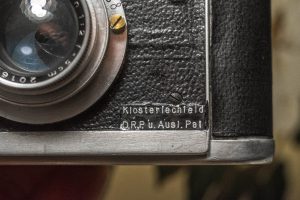
The Riwa is one of the more complete of the prototype cameras I was able to handle in my visit to the Voncabbage Collection. This is likely a prototype for a new kind of 35mm SLR that someone or some company had intended to put into production in the first half of the 20th century.
I did my best researching this camera and could not find any information online anywhere about this camera. Not even the excellent Novacon Oddity Cameras has anything about the Riwa. Further adding to the mystique is the engraving in the bottom right corner of the front plate, which says “Klosterlechfeld D.R.P. u. Ausl. Pat”. The word Klosterlechfeld refers to a village in the district of Augsburg in Bavaria in Germany where this camera was probably made.
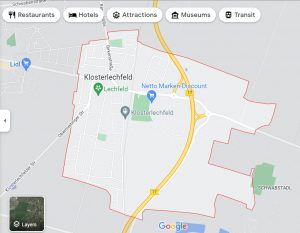
At the time this camera was likely made, Klosterlechfeld would have been in West Germany, about 70km west of Munich, and to the best of my knowledge, did not have any sort of camera or optics industry. Reaching out to a couple German-based collectors, I showed them photos of this camera and asked if they had heard of anything being made there and they were as equally as clueless as I was.
In terms of when this camera was made, my best guess is early 1950s, as the 201xxxx serial number on the Rodenstock Heligon lens dates it to that era, but also the letters “D.R.P.”, which stands for Duetsche Reichspartei, or German Reich Party, did not exist prior to 1950.
Edit 3/3/2022: After posting this article, a few astute readers who know more about German history than I, pointed out that D.R.P. almost certainly stands for “Deutsches Reichspatent” which when followed by “u. Ausl. Pat.” or “and foreign patents” makes much more sense. Reddit reader u/Oldico goes on to say that this nomenclature most certainly dates the camera to before 1945, possibly even prewar, meaning the Riwa is most likely a pre- or during war camera.
With the camera in my hand, the metal work is good. Not Leitz good, but better than that of cheap stamped metal designs of the mid 20th century. The overall width, depth, and weight are similar to that of a screw mount Leica. The height, both of the top plate, and the top of the waist level finder are a bit taller than the Barnacks, however.

The Riwa is a focal plane SLR with a really nice collapsible 5cm f/2 Rodenstock Heligon lens and an interchangeable lens mount. The camera uses what looks like a normal M39 screw mount, however, the Heligon mounted to it looks to be specially modified to fit the narrow depth of the Riwa mount. In my attempt to screw a normal Leica Thread Mount lens onto the Riwa, the lens would bottom out before reaching the end of the screw threads, suggesting it would never focus to infinity with anything but the original lens.
This would have been a missed opportunity for whoever was designing this camera, as if they could have made it work with M39 Leica Thread Mount lenses, potential customers of the Riwa would have had access to a huge number of German, Japanese, and Soviet M39 lenses. This would have put the Riwa in rare company with cameras like the Corfield Periflex who worked like an SLR, but could use rangefinder lenses.
Even more frustrating, is that the creators of the Riwa had already solved the biggest challenge of using a rangefinder lens on an SLR, which is avoiding the increased depth of an SLR necessitated by the thickness of the mirror box.
Most SLRs use a reflex mirror that needs to swing down to reflect light into the viewfinder to compose an image, and then swing back up to allow light to pass through the lens to the shutter in order to expose an image. Since the mirror needs to be at least as large as the exposed image the camera produces, which for 35mm SLRs is 24mm x 36mm, the physical size of the mirror box requires the lens to be pushed farther away from the focal plane than in a rangefinder.
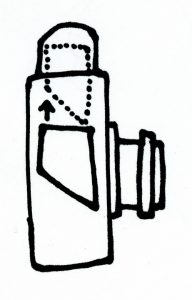
This is the reason why early KMZ Zenit SLRs that use the M39 lens mount, cannot accept M39 rangefinder lenses even though the physical lens mount is the same. Lenses designed for M39 rangefinders will never focus correctly on an M39 Zenit because the lens itself is too far away from the focal plane as a result of the mirror box.
Whoever built the Riwa got around this by installing the reflex mirror at a permanent 45 degree angle, without any ability to fold up. With the mirror in the “down” position, there is just enough room to keep the mirror in there, without having to put the lens mount farther away from the focal plane, meaning that M39 rangefinder lenses could, in theory, be used.
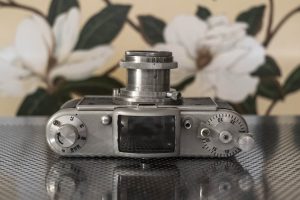
But of course, you can’t shoot through a mirror (at least not unless it is a pellicle mirror), so the Riwa’s mirror is designed similarly to the periscope mirror in the Corfield Periflex, in that when pressing the shutter release, the entire mirror assembly, lifts up out of the way of the film plane, allowing light to pass through. The mirror remains in it’s angled state, but simply rises up into the box like shape containing the waist level finder on top of the camera.
When it comes time to shoot another exposure, a long plunger to the left of the viewfinder, opposite of the shutter release, is pressed down to lower the mirror back into it’s viewing position, allowing you to see through the viewfinder again.
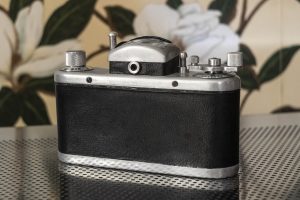
As with most waist level finders, the image through the viewfinder is reversed left to right, so moving the camera to the left, gives the appearance of moving the lens to the right and vice versa. Since the viewfinder image is through the lens, changes to focus and aperture affect how light passes through it and if you have the lens stopped down, the image can get quite dark. For instances where fast action is required, the Riwa also has a “sports finder” on the back of the viewfinder which allows you to see straight through a rectangular window on the front edge of the viewfinder. Just like the waist level finder, the reflex mirror must be in the down position to use the sports finder.
Whoever designed the Riwa went to great lengths combining features in the same location to eliminate clutter. Shutter speeds are changed with a round dial on the left side of the top plate, beneath the rewind knob. The cable threaded shutter release is next to the combination exposure counter and film advance….”thing”. Featuring two posts connected to an axle going through a shaft into the camera, the Riwa uses neither a knob nor a lever, but it does appear to work well, allowing you a good amount of grip when advancing the film.

Perhaps the biggest mysteries of the Riwa is how exactly film is loaded. When I first handled the camera, I assumed it was a bottom loader. After all, the Leica and so many other similar cameras loaded from the bottom, and without an obvious hinge on the side of the camera for a door, I assumed you just removed the bottom plate to load film. The thing is, after looking at all sides of the camera, no such latch, hinge, key, or lock exists. It is almost as if the camera is a sealed box.
Not wanting to explore any further, I ended my visit with the Voncabbage Collection and went home, but after I started working on this review, it ate at me and I contacted the owner of the camera and asked if they would be willing to look into opening it up.
Amazingly, the only way to open the camera was by removing some screws and sliding the entire back and bottom of the camera off. This reveals the film compartment with fold out film pressure plate and odd looking shutter curtains. Film transports from left to right onto a slotted and fixed take up spool. The shutter however appears to be in two pieces as a prominent seam runs down the middle before and after the shutter is cocked. It seems unlikely to me that any camera would go into production with a film compartment that requires you to remove screws to gain access to, so perhaps this was a design element that hadn’t yet been fully completed when this prototype was built.
Watch the short video below of the shutter firing on this interesting camera.
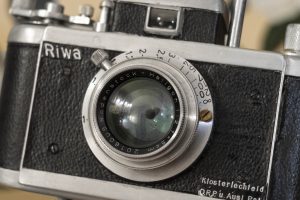
And that’s about it. I wish I could tell you more about the shutter, the lens mount, it’s history, who designed it, and why it was never made. I wish I could have shot one, but I didn’t. The owner of this camera knows nothing about it. They said that one day the opportunity to buy a camera they had never seen before came, and they took it. Whoever previously owned it knew nothing about it, the current owner knows nothing about it, I know nothing about it, and now you too, can know nothing about it!
The Riwa is an interesting camera that had it made into production, likely would have been a cost effective entry into the world of SLRs. Although this prototype cannot accept regular 39mm LTM lenses, it’s plausible that a finished copy might have, and if so would have meant the camera would have been compatible with a great number of rangefinder lenses already on the market. The lack of a pentaprism not only keeps the camera’s size and weight down, but also it’s cost as the effort and skill required to machine a piece of glass into a pentaprism shape in the early 1950s was still quite high.
It is impossible to guess how successful the camera might have been, or what it would have cost, but I have to imagine that it probably would have sold in modest numbers to current rangefinder camera owners curious about SLRs, while not wanting to invest in an entirely new lens system.
Related Posts You Might Enjoy
External Links
None

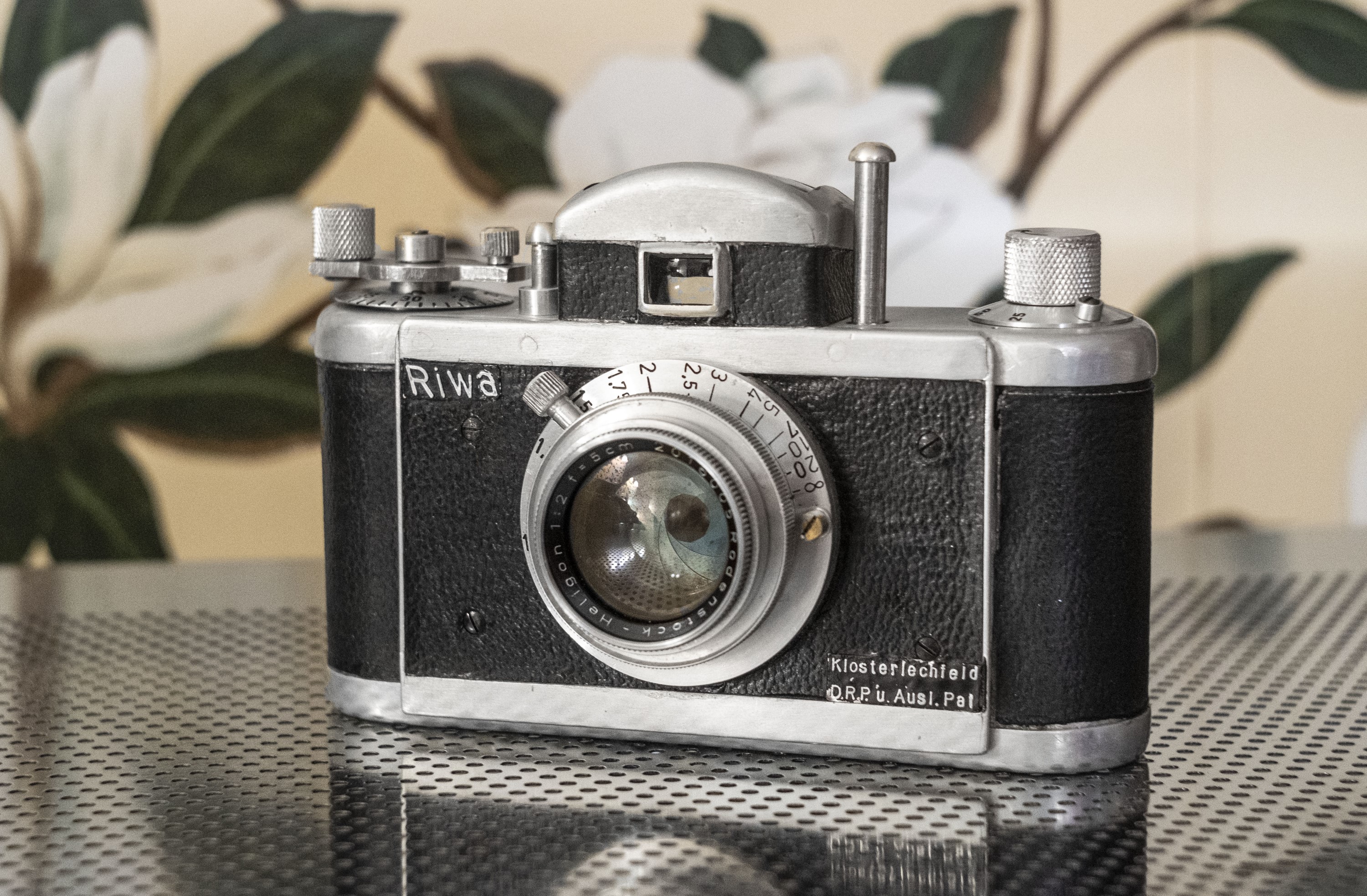
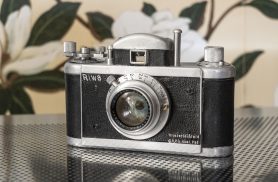
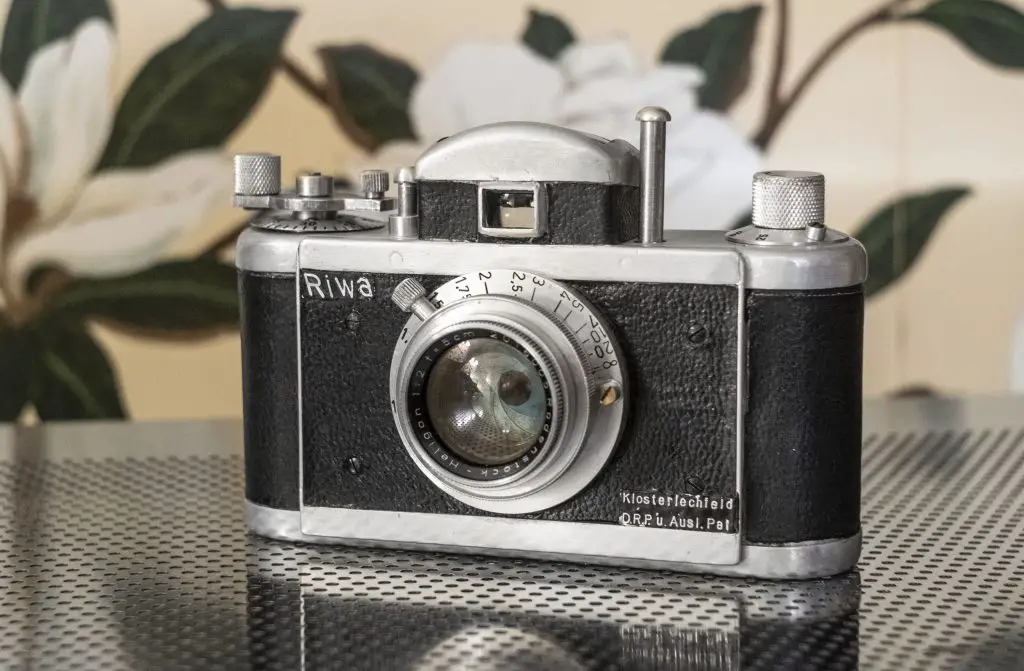

I think that if the mirror is kept in the “up” position, you CAN mount an unmodified LTM lens on it. It is the rangefinder coupling ring on the lens that prevents if from mounting fully when the mirror is in the “down” position. I will double check and update you the next time I am in “the vault”
Good to know, but is there a way to cock and fire the shutter without dropping the mirror?
If you have a Zenit 3M at hand, try its lens on this camera. The flange focal distance will likely be very similar, as both have mirror boxes. I envy your access to Von Cabbage’s stash!
The Riwa has the same flange distance as a Leica, so mounting a Zenit 3M lens to it would have the same problem as mounting those lenses to a Zorki. It seems whoever was creating the Riwa had the idea of sharing rangefinder lenses on an SLR-like camera, just like the Corfield Periflex. Sadly, they never completed their vision, or got around the lens bottoming out when mounted to the camera.
DRP should stand for Deutsches Reichspatent, which is how patents used to be known in Germany. At some point the abbreviation became DBP for Deutsches Bundespatent. For example, you’ll see Leicas marked DRP or DBP. Someone might find more information on the Riwa with a German patent search.
Thanks William. Several people pointed this out to me and I made the corrections to the review!
The answer, of course, was making a mirror that drops down upon pressing the shutter button. That’d allow for a true reflex TTL experience on a rangefinder body. Which makes me wonder just why did no one make that (but perhaps I’m wrong?). Still, this is an amazingly interesting camera, a truly unique prototype.
How come no one in Japan tried something like this? LTM was used by Canon, Nicca and others, so the mount was well known and used there.
So many questions…
French. Foca Focaflex series. Looks a bit like a giant PEN F. Full frame, prism, rangefinder look and the mirror drops to the floor.
Did it really? I’ve never been able to confirm that, despite spending hours looking at poorly-translated FOCA websites (I own a Universel R, probably the most handsome camera in my collection). I know it apparently has the prism on the bottom, instead of the top. The Focaflex II doesn’t share the Universel mount, however, which kinda defeats the purpose of my idea.
It is strange. As far as I can work it out from a diagram I found, the 45deg ‘viewing’ mirror is a pellicle semi-silvered type and the mirror box floor is also a horizontal mirror! As far as I can work out without dismantling one of mine the view is reflected down into the floor mirror and then back up through the angled mirror to the viewfinder, thus correcting the left/right orientation. The ‘prism’ is a simple angle block which does not correct the image. When the trigger is actuated, a small shutter blocks the eye level finder internally to prevent a light leak, the 45deg translucent mirror drops down on to the floor mirror and the focal plane shutter fires. It is quite the most bizarre design and so, very French. (no Francophobic comments please – some of my favourite relatives are French and I won’t take it well). If I could find a way of adding a jpeg to this post I’d include an original advert which had a good diagram of the convoluted light path – but… Email me and I’ll shoot it across.
Doesn’t the focaflex have a full frame version of the Olympus pen f’s viewing system?
Thanks for that, Andrew. I later found the diagram, and it’s indeed quite bizarre. Nothing that a German designer couldn’t have come up with, though (they also loved to overcomplicate their stuff!)